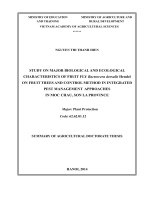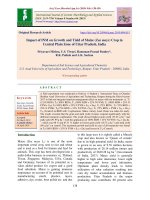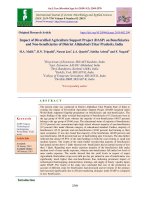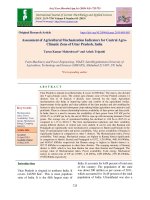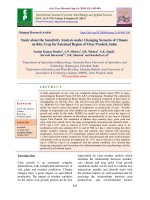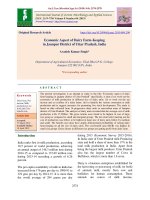Species complex of fruit flies, Bactrocera spp. (Diptera: Tephritidae) infesting guava in western Uttar Pradesh, India
Bạn đang xem bản rút gọn của tài liệu. Xem và tải ngay bản đầy đủ của tài liệu tại đây (293.11 KB, 10 trang )
Int.J.Curr.Microbiol.App.Sci (2019) 8(8): 2501-2510
International Journal of Current Microbiology and Applied Sciences
ISSN: 2319-7706 Volume 8 Number 08 (2019)
Journal homepage:
Original Research Article
/>
Species Complex of Fruit Flies, Bactrocera spp. (Diptera: Tephritidae)
Infesting Guava in Western Uttar Pradesh, India
Irsad* and Masarrat Haseeb
Department of Plant Protection, Faculty of Agricultural Sciences, A.M.U., Aligarh, India
*Corresponding author
ABSTRACT
Keywords
Fruit fly, Species
complex,
Proportionate
population, Guava
Article Info
Accepted:
22 July 2019
Available Online:
10 August 2019
The species diversity of Dacinae fruit flies (Bactrocera spp.) was monitored in guava
growing areas in various districts of western Uttar Pradesh, India, over a 12 months period
(October, 2017- September, 2018). Samples of fruit flies were collected by using methyl
eugenol lure traps and infested guava fruits collected from the farmer’s orchards in fruiting
season. Three species of fruit flies recorded were, Bactrocera correcta, B. dorsalis and B.
zonata. In general, proportionately higher population of B. zonata was recorded form
various places surveyed. There was not much difference in species composition in
different places. However, on an average, population differences were noticed in different
areas. Number of adult fly emergence from the infested guava fruits collected from
different places was proportionately in the range of 21.00-69.85%, 21.06-49.80% and
20.12%-43.65% for B. zonata, B. dorsalis and B. correcta, respectively.
Introduction
Guava is the fourth most important fruit (after
mango, banana, and citrus), commercially
cultivated in India with an estimated area of
261 thousand hectares and production of 3916
thousand MT (Anonymous 2017). Among the
Indian states, Uttar Pradesh tops with the
maximum cultivation of guava with an area of
99 thousand hectares and production of
919.94 thousand MT (Anonymous 2017). In
India, particularly in Uttar Pradesh, guava
suffers colossal losses due to infestation of
fruit flies and is a major limiting factor among
the insect pests infesting this crop (Kapoor,
2002; Rajitha and Viraktamath, 2006; Haseeb,
2007). Fruit flies are a regular pest in chief
guava growing areas of Uttar Pradesh i.e.
Allahabad, Kaushambi, Lucknow, Faizabad
(Eastern and Central UP), Farrukhabad, Sasni,
Sadabad, Badaun (Western UP). However, it
has been observed that this crop suffers
maximum in rainy season resulting in the
heavy reduction in fruit production (Haseeb,
2007 and Haseeb, et al., 2010).
Fruit flies belonging to the family tephritidae
are the most diversified group of insects and
they are considered as significant and serious
pests of horticultural crops the world over. A
2501
Int.J.Curr.Microbiol.App.Sci (2019) 8(8): 2501-2510
number of species of fruit flies gained entry in
places other than its origin and have been
recorded as alien species causing serious
infestations and losses. It is a major pest of
significance because of its polyphagous
nature, cosmopolitan distribution, nature of
the damage, resulting losses and quarantine
status (Kapoor, 2006; Drew et al., 2007;
Drew and Romig, 2013; Liu et al., 2013;
Ukey et al., 2013). Among the tephritid fruit
flies, sub family Dacinae possess maximum
number of economically important species.
The Dacinae is a large group of tephritid fruit
flies, with over 800 described species,
primarily within the genera Bactrocera and
Dacus. Of these, about 60 are known to occur
in India, mostly infesting edible host fruits
and fleshy vegetables, resulting in fruit losses
(Nair et al., 2018). Among the Dacinae fruit
flies the genus Bactrocera is of significance
as it contains economically important species,
with particular reference to B. dorsalis, B.
correcta, B. zonata, B. cucurbitae which have
been reported to potentially infest more than
173 kinds of fruits and vegetables including
mango, banana, peach, guava, citrus spp.,
apricot, rose apple, jujube, Chinese date, fig,
sapodilla, cucurbits and other vegetables
(Gupta & Verma, 1978; White & ElsonHarris, 1992; Allwood et al., 1999; Drew &
Raghu, 2002; Verghese et al., 2004; Dhillon
et al., 2005; Ekesi et al., 2016).
Among fruits, guava is one of the highly
susceptible fruit of commercial importance
which is attacked by different species of fruit
flies. The extent of damage/crop losses due to
fruit flies have been recorded to vary between
16-40 per cent (Arora et al., 1998); 60-80 per
cent (Jalaluddin et al., 1999); 10-80 per cent
(Verghese et al., 2002); 20-46 per cent
(Haseeb, 2007); few per cent -100 per cent
(Kumar et al., 2011); up to 100 per cent
(Mondal et al., 2015). In western Uttar
Pradesh, Sasni (Hathras near Aligarh), the
most important area, famous for guava
cultivation has been found suffering from
heavy infestation of fruit flies in rainy season
guava and increasing population noticed in
winter season too as indicated by the results
of preliminary surveys (Haseeb et al., 2010).
As the information on species complex of
fruit flies was not available from this area, the
present studies were undertaken to explore the
fruit fly species complex, so that proper
management strategies may be chalked out to
control the pest in this area and in other areas
of western UP.
Materials and Methods
Study sites
The present studies were carried out from
October 2017 to September 2018 in guava
orchards of districts, namely: Aligarh,
Hathras, Bulandshahar, Agra, Firozabad,
Mathura, Badaun and nearby areas in Western
U. P., This study aimed to explore the fruit fly
complex in guava in western Uttar Pradesh,
mainly Sasni (Hathras), a chief
guava
growing area in the region. (Fig 1).
Collection of specimens
Fruit flies were collected by the following two
methods:
Use of Para-pheromone traps: Fruit fly plastic
traps with the transparent bowl and the yellow
cap having an entry hole of 6 cm in diameter
were used. These traps were purchased from
Devine trap industries, Kolkata, West Bengal.
Transparent water bottle traps were also
prepared in the laboratory and installed in
selected guava orchards. Liquid lures (Methyl
eugenol) used in traps to attract fruit flies
(males), were obtained from Apex Life
Sciences, New Delhi. Traps baited with
methyl–eugenol were installed in two
orchards at each locality at a distance of 20
meters and 5 feet height above the ground.
2502
Int.J.Curr.Microbiol.App.Sci (2019) 8(8): 2501-2510
Flies were collected from the traps at the
weekly interval and brought to the laboratory,
observed under a binocular microscope for
the identifications.
New Delhi. The specimens of fruit flies were
also deposited in the National Pusa Collection
at Pusa, IARI, New Delhi.
Results and Discussion
Rearing of flies from infested fruits: The
infested guava (selected out of harvested and
freshly fallen fruits), were collected from the
orchards in fruiting season and brought to the
laboratory. Such fruits were placed in rearing
cages provided with sterilized sand at the
bottom so as to facilitate pupation. The
emerged fruit flies were provided with Protein
hydrolysate, glucose and water soaked in a
cotton swab for a week. In this way, flies were
allowed to complete the process of
sclerotization and development of colour so
as to facilitate identification.
Data were also recorded on proportionate
population of different fruit fly species reared
from infested fruits brought to the laboratory
from different places to know the relative
distribution and abundance. Number of
different species emerged out of infested
guava fruits were counted and percentage out
of the total flies emerged, was calculated.
Data analysis was done by using Minitab
software, 2018.
Identification of specimens
The collected flies were killed by using a
killing agent (Ethyl acetate/Chloroform) and
examined under a binocular microscope. The
flies were identified to the species level. On
the basis of morphological characters with the
help of taxonomical keys (Source: Dr. C. A.
Viraktamath and Dr. K. J. David, UAS,
GKVK, Bangalore). The number of species at
a particular locality was recorded. The fruit
flies also got identified from Insect
Identification Services, National Pusa
Collection, Division of Entomology, IARI,
Species of fruit flies caught in parapheromone (methyl eugenol) traps
As a result of present investigations, fruit fly
species recorded in guava growing areas of
western Uttar Pradesh are presented in Table1. Three species of fruit flies, viz. B. correcta,
B. dorsalis, and B. zonata were recorded from
various districts i.e. Hathras (Sasni, Samamai
Ruhal), Aligarh, Agra, Bulandshahar, Badaun.
However, only 2 species of fruit flies, viz. B.
dorsalis and B. zonata were recorded from
Chhatarpur locality in Hathras district and
district
Firozabad.
In
general,
a
proportionately higher population of B.
zonata was recorded trapped to methyl
eugenol traps followed by B. dorsalis and B.
correcta.
Species of fruit flies reared from infested
guava fruits
Species of fruit flies bred from guava fruits
collected from different localities/districts
were identified as B. correcta, B. dorsalis and
B. zonata.
All the three species were
recorded from Hathras (Sasni, Samamai
Ruhal), Aligarh, Agra, Bulandshahar, Badaun
districts. Whereas, only 2 species viz., B.
dorsalis and B. zonata were recorded from
Hathras locality Chhatarpur, Mathura and
Firozabad as indicated in the Table-1.
Fruit fly (Bactrocera spp.) community
structure and their distribution at different
districts/ areas of western Uttar Pradesh are
depicted in the Map (Fig. 1).
2503
Int.J.Curr.Microbiol.App.Sci (2019) 8(8): 2501-2510
Table.1 Species of fruit flies caught through ME traps and reared from infested guava fruits
S. N.
District
Locality
1.
Hathras
Sasni
Samamai
Ruhal
2.
Aligarh
No. of Species of fruit flies Species of fruit flies
species caught in para- reared from infested
pheromone trap
guava
fruits
in
laboratory
03
Bactrocera correcta Bactrocera correcta
(Bezzi)
(Bezzi)
Bactrocera dorsalis Bactrocera dorsalis
(Handel)
(Handel)
Bactrocera
zonata Bactrocera
zonata
(Saunders)
(Saunders)
03
Bactrocera correcta Bactrocera correcta
Chhatarpur
02
Rajkiya
Jawahar
Udhyan
03
Bactrocera dorsalis
Bactrocera zonata
Bactrocera dorsalis
Bactrocera zonata
Bactrocera correcta
03
Bactrocera dorsalis
Bactrocera zonata
Bactrocera correcta
Bactrocera dorsalis
Bactrocera zonata
Bactrocera correcta
Bactrocera dorsalis
Bactrocera zonata
Bactrocera zonata
Bactrocera dorsalis
Bactrocera zonata
Bactrocera correcta
Bactrocera zonata
Bactrocera zonata
Bactrocera correcta
Bactrocera dorsalis
Bactrocera zonata
Bactrocera dorsalis
Bactrocera correcta
Bactrocera dorsalis
Bactrocera zonata
Bactrocera correcta
Bactrocera dorsalis
Bactrocera zonata
Bactrocera dorsalis
Bactrocera correcta
Bactrocera dorsalis
Bactrocera zonata
Bactrocera correcta
Bactrocera dorsalis
Bactrocera zonata
Botanical
garden
3.
Mathura
Koshi Khurd
02
4.
Bulandshahar
Pandrawal
03
5.
Firozabad
Navalpur,
Eka
02
6.
Agra
Bichpuri
03
7.
Badaun
Kakrala
03
2504
Bactrocera dorsalis
Bactrocera zonata
Bactrocera dorsalis
Bactrocera zonata
Bactrocera correcta
Int.J.Curr.Microbiol.App.Sci (2019) 8(8): 2501-2510
Table.2 Proportionate population of different species of fruit flies, Bactrocera spp. as reared
from infested guava fruits
S. No.
District
Locality
Species of fruit flies
reared from infested
guava
fruits
in
laboratory
Bactrocera correcta
Bactrocera dorsalis
Bactrocera zonata
Bactrocera correcta
Per-cent
Total
1.
Hathras
Sasni
29.49
30.75
39.76
28.76
556
Bactrocera dorsalis
Bactrocera zonata
Bactrocera dorsalis
Bactrocera zonata
Bactrocera correcta
31.08
40.16
30.15
69.85
29.20
Bactrocera dorsalis
Bactrocera zonata
Bactrocera correcta
49.80
21.00
24.36
Bactrocera dorsalis
Bactrocera zonata
Mathura
Koshi khurd Bactrocera correcta
Bactrocera zonata
Bulandshahar Pandrawal
Bactrocera zonata
Bactrocera correcta
Bactrocera dorsalis
Firozabad
Navalpur,
Bactrocera zonata
Eka
Bactrocera dorsalis
Agra
Bichpuri
Bactrocera correcta
Bactrocera dorsalis
Bactrocera zonata
Badaun
Kakrala
Bactrocera correcta
36.92
38.72
43.65
56.35
58.82
20.12
21.06
68.82
Bactrocera dorsalis
Bactrocera zonata
35.83
32.57
Samamai
Ruhal
Chhatarpur
2.
Aligarh
Rajkiya
Jawahar
Udhyan
Botanical
garden
3.
4.
5.
6.
7.
2505
31.18
36.19
35.88
27.93
31.59
518
322
440
612
380
350
330
315
307
Int.J.Curr.Microbiol.App.Sci (2019) 8(8): 2501-2510
Table.3 Mean population of different species at given locality
Location
B. correcta (Mean) B. dorsalis (Mean) B. zonata (Mean)
34.20
32.80
44.20
Sasni
32.20
29.80
41.60
Samamai Ruhal
0.00
19.60
44.80
Chhatarpur
25.60
43.80
18.60
Rajkiya Jawahar Udhyan
29.80
45.20
47.40
Botanical garden
33.20
0.00
42.80
Mathura
0.00
20.60
45.40
Firozabad
22.80
22.60
17.60
Bichpuri
19.40
22.00
20.00
Kakrala
14.00
14.80
41.20
Bulandshahar
LSD 9.19
LSD10.58
LSD 13.278
F 17.36
F 15.66
F 11.02
P <0.005
P <0.005
P <0.005
Fig.1 Sampling site and distribution of fruit fly community are indicating
by different colours in map
2506
Int.J.Curr.Microbiol.App.Sci (2019) 8(8): 2501-2510
As a result of present studies fruit fly complex
comprising species of B. correcta, B. dorsalis,
and B. zonata, was recorded as of common
occurrence in most of the guava growing
areas of western Uttar Pradesh (Table 1,
Fig.1). The present findings with regard to the
species complex of fruit flies are in agreement
with the observations made by Kadam, U.K.,
(2012). The author recorded B. dorsalis, B.
caryeae, B. correcta and B. zonata in methyl
eugenol traps. Verghese and Jayanthi (2001)
recorded the species of B. dorsalis and B.
correcta infesting guava in Bangalore.
Madhura and Viraktamath (2003) recorded
five species of fruit flies, viz., B. dorsalis, B.
correcta, B. verbascifoliae, B. affinis and B.
zonata at Bangalore. Kawashita et al., (2004)
recorded B. correcta, B. dorsalis and B.
zonata. Dale and Patel (2010) recorded B.
dorsalis and B. zonata from Gujarat. B.
correcta, B. dorsalis, and B. zonata complex
was also reported from Ahmednagar district
of Maharashtra from methyl eugenol lure
traps and also from fruits of guava (Ukey et
al., 2013). Kumar et al., (2018) recorded four
species, viz., B. correcta, B. diversa, B.
dorsalis and B. zonata from mango orchards
from Meerut and Saharanpur areas of western
Uttar Pradesh from methyl eugenol traps.
Along with this complex few other species of
Bactrocera have been recorded primarily
from guava and mango and some other fruits
from various regions of the country (Madhura
and Verghese, 2003; Satarkar et al., 2006;
Deepa et al., 2009; Deepa et al., 2010;
Haseeb et al., 2010; Galande and Ukey, 2011,
Nair et al., 2018). As reported in the present
findings, these species were reared from
infested guava fruits by earlier workers also
(Kapoor, 1993; Jalaluddin et al., 1999; Gupta
and Bhatia, 2000; Jalaluddin, et al., 2001;
Khan et al., 2005; Haseeb, 2007; Ukey et al.,
2013).
However, the proportionate population of
these species varied as caught in methyl
eugenol lure traps and as reared from infested
guava at different places surveyed (Table-2)
as also reported by earlier workers. Findings
of present studies revealed the dominance of
B. zonata as observed from the data recorded
on the emergence of flies from infested fruits
collected from most of the areas surveyed,
ranging from 21.00-69.85%, 21.06-49.80%
and 20.12%-43.65% for B. zonata, B. dorsalis
and B. correcta, respectively. Haseeb et al.,
2507
Int.J.Curr.Microbiol.App.Sci (2019) 8(8): 2501-2510
(2010) recorded B. zonata as dominant
species from Aligarh region. Khan et al.,
(2005) recorded proportionately higher
number of B. zonata flies (49.62%) on guava.
Jalaluddin et al., (1999, 2001) recorded B.
correcta as dominant species. Mandal et al.,
(2015) recorded B. correcta as dominant
species on guava from Baruipur region in
West Bengal contributing 90 per cent yield
loss. Ukey et al., (2013) observed B. dorsalis
(49.95%) to be dominant species followed by
B. zonata (31.36%) and B. correcta (19.95%)
of the total number of emerged flies as
studied in Ahmednagar, Maharashtra.
According to Kapoor (2002) B. correcta, B.
dorsalis and B. zonata species complex was
reported as the most important fruit fly pest
complexes in India. They are of common
occurrence, widely distributed in guava
growing regions throughout India and attack
almost similar hosts, e.g. guava, mango, etc.
while B. zonata also attack peaches. In the
past two decades it has been observed that
species, B. zonata has taken over B. dorsalis
in the intensity of attack, number and host
range as also indicated by the results of
present findings.
Acknowledgments
The authors are grateful to the Council of
Science and Technology, Uttar Pradesh,
Lucknow for providing financial assistance to
carry out this study under the project,
“Incidence and management of fruit flies,
Bactrocera spp., in guava ecosystem in
Western Uttar Pradesh”.
The authors are also thankful to Dr. D.K.
Srivastava, Joint Director, CST UP for his
timely help and support in dealing with
matters related with the project.
The authors are highly thankful to Dr.
Debjani Dey, In-Charge, Insect Identification
Services, National Pusa Collection, Division
of Entomology, IARI, New Delhi for the help
provided in the identification of fruit fly
species. The authors are also grateful to
Dean, Faculty of Agricultural Sciences and
the Chairman, Department of Plant
Protection, Aligarh Muslim University,
Aligarh for necessary facilities provided for
this study.
References
In conclusion, fruit fly, Bactrocera spp. is the
serious Problem in the guava fruit crop in
Western Uttar Pradesh. Due to availability of
host plants throughout the year their
infestation is increasing day by day.
Bactrocera spp. are infesting many host
species throughout the entire geographical
range. The knowledge of species complex,
distribution and population abundance of fruit
flies may help in devising management
strategies in the region. As a result of survey
and surveillance, three species of fruit flies,
viz. B. correcta, B. dorsalis and B. zonata
were found infesting guava in most of the
guava growing areas of western Uttar
Pradesh. However, B. zonata was found the
most frequent and dominant species
associated with guava in the region.
Allwood,
A.
J.,
Chinajariyawong,
A.,
Kritsaneepaiboon, S., Drew, R. A. I.,
Hamacek, E. L., Hancock, D. L., and
Leong, C. T. S. 1999. Host plant records for
fruit flies (Diptera: Tephritidae) in
Southeast Asia. Raffles Bulletin of Zoology,
47(Supplement 7), 1-92.
Arora, P.K., Batra, R.C., Mehrotra, N.K. & Thind,
S.K. 1998. Screening of some promising
guava varieties against fruit fly. In: Reddy,
P.P., Krishna Kumar, N.K. & Verghese, A.
(Eds) Proceedings of the first National
Symposium on Pest Management in
Horticultural
Crops:
Environmental
implications
and
thrusts
101-102.
Association for Advancement of pest
Management in Horticultural Ecosystem,
Bangalore.
Dale, N. S. and Patel, R. K., (2010). Population
2508
Int.J.Curr.Microbiol.App.Sci (2019) 8(8): 2501-2510
dynamics of fruit flies (Bactrocera spp) on
guava and its correlation with weather
parameters, Current Biotica. 4 (2): 245248.
David, K. J., and Ramani, S. 2011. An illustrated
key to fruit flies (Diptera: Tephritidae) from
Peninsular India and the Andaman and
Nicobar Islands. Zoo taxa, 3021, 1-31.
Deepa M, and Agarwal, N. 2010. Studies on
population dynamics of fruit flies of
Bactrocera dorsalis complex. Indian
Journal of Entomology, 72: 382-384.
Deepa, M., Neeraja Agarwal, Rahul Viswakarma,
Kiran Kumari and Mithali K. L., 2009.
Monitoring and weather parameters on
Bactrocera complex through methyl
eugenol traps. Annals of Plant Protection
Sciences., 17 (2): pp. 332-336.
Dhillon, M. K., Singh, R., Naresh, J. S., and
Sharma, H. C. 2005. The melon fruit fly,
Bactrocera cucurbitae: a review of its
biology and management. Journal of Insect
Science, 5(1), 40.
Drew, R. A. I., and Raghu, S. 2002. The fruit fly
fauna (Diptera: Tephritidae: Dacinae) of the
rainforest habitat of the Western Ghats,
India. Raffles Bulletin of Zoology, 50(2),
327-352.
Drew, R. A. I., Romig, M. C., and Dorji, C. 2007.
Records of Dacinae fruit flies and new
species of Dacus (Diptera: Tephritidae) in
Bhutan. The Raffles Bulletin of Zoology, 55:
1-21.
Drew, R. A., and Romig, M. C. 2013. Tropical
Fruit Flies (Tephritidae Dacinae) of SouthEast Asia: Indomalaya to North-West
Australasia. CABI.
Galande, S. M. and Ukey, N.S. 2011. Fruit fly,
Bactrocera species composition in Pune
region of Maharashtra state. Journal of
Applied Zoological Research, 22 (1): 1-4.
Gupta D and Bhatia R. 2000. Population
fluctuations of fruit flies, Bactrocera spp. in
sub mountainous mango and guava
orchards. Journal of Applied Horticulture 2
(1): 47–9.
Gupta, J. N. and Verma, A. N., 1978. Screening of
different cucurbit crops for the attack of the
melon fruit fly, Dacus cucurbitae Coq.
(Diptera: Tephritidae). Haryana Journal of
Horticulture Sciences., 7: 78 - 82.
Haseeb, M. 2007. Current status of insect pest
problem in guava. Acta Horticulture. 735:
453-468.
Haseeb, M., Varshne, D., Qamar, M., and Sharma,
D. K. 2010. Biology and morphometries of
Bactrocera zonata on guava. Annals of
Plant Protection Sciences, 18: 508-510.
/>e%20At%20a%20Glance%202017%20for
%20net%20uplod%20(2).pdf.
Jalaluddin, S. M., Natarajan, K. and Sadakathulla,
S., 2001. Population fluctuation of the
guava fruit fly, Bactrocera correcta (Bezzi)
in relation to hosts and abiotic factors.
Journal of Experimental Zoology. 4: 323327.
Jalaluddin, S.M. Natarajan, K., Sadakathulla, S.
and Balasubramaniyan, S. 1999. Discovery
of the guava fruit fly Bactrocera correcta
(Bezzi). Entomon. 24: 195-196.
Kadam, U. K., 2012. Studies on species diversity,
population dynamics and management of
fruit flies in guava (Psidium guajava L.).
Ph. D thesis, Mahatma Phule Krishi
Vidyapeeth,
Rahuri-413
722,
dist.
Ahmednagar, Maharashtra, India 1-160 pp.
Kapoor, V. C. 2002. Fruit-fly pests and their
present status. Proceedings of 6th
International Symposium, 6-10 May, 2002,
Stellenbosch, South Africa, pp.23-33.
Kapoor, V. C. 2005. Taxonomy and biology of
economically important fruit flies of India.
Israel Journal of Entomology, 35-36: 459.
Kapoor, V. C. 2006. Taxonomy and biology of
economically important fruit flies of
India. Israel
Journal
of
Entomology, 35:459-475.
Kapoor, V.C., (1993). Indian fruit flies (Insecta:
Diptera: Tephritidae), oxford and IHB
publishing company, New Delhi.
Kawashita, T., Rajapakse, G. B. J. P., and Tsuruta,
K. 2004. Population surveys of Bactrocera
fruit flies by lure trap in Sri Lanka.
Research Bulletin of the Plant Protection
Service (Japan).
Khan, M. A., Muhammad, A., Waseem, A. and
Lee, L. L., 2005. Management of fruit flies
of the most perishable fruit. Entomological
Research. 35 (2): 79-84.
Kumar, P., Abubakar, Linda, A., Ketelaar, J.W.
and Shanmugam, V. 2011. Fruit fly damage
2509
Int.J.Curr.Microbiol.App.Sci (2019) 8(8): 2501-2510
and crop losses. In: Field Exercise Guide
on Fruit Flies Integrated Pest Management,
Asian Fruit Fly IPM Project, Bangkok,
Thailand, pp. 17.
Kumar, U., Prasad, C. S., Vaibhav, V. and Saran,
S. 2018. Population dynamics of mango
fruit fly species caught through methyl
eugenol traps at different locations of
Western
plain
zone
of
Uttar
Pradesh. Journal of Pharmacognosy and
Phytochemistry, 7: 2167-2168.
Liu, X., Jin, Y. and Ye, H. 2013. Recent spread
and climatic ecological niche of the
invasive guava fruit fly, Bactrocera
correcta, in mainland China. Journal of
pest science, 86: 449-458.
Madhura, H. S., and Viraktamath, C. A. 2003.
Efficacy of different traps in attracting fruit
flies
(Diptera:
Tephritidae).
Pest
Management In Horticultural Ecosystems,
9(2).
Mondal, C., Garain, P. K., Maitra, N. J. and Atit,
M. 2015. Biofriendly management of guava
fruit fly (Bactrocera correcta Bezzi)
throygh wrapping technique. Journal.
Applied and Natural Sciences, 7:358-363.
Nair, N., Bhattacharjee, T., Thangjam, B., Giri,
U.and Debnath, M.R. 2018. Species
diversity of Dacine fruit flies (Diptera:
Tephritidae: Dacinae:Dacini) in Tripura, N.
E. India. Journal of Entomology and
Zoology Studies, 6 (1): 297-302.
nhb.gov.in/statistics/State
Level/201718(1st%20Adv.%20Est).pdf
Rajitha, A. R. and Viraktamath, S. 2006.
Monitoring fruit flies (Diptera: Tephritidae)
in guava orchard in Dharwad, Karnataka.
Karnataka
Journal
of
Agricultural
Sciences, 19: 35-39.
Satarkar, V.R., Krishnamurthy, S.V., Falerio, J.R.,
Verghese, A. and Stonehouse, J.M. 2006.
An assessment of methyl eugenol
dispensers and fruit fly species complex in
orchard agro-ecosystems of Goa, India.
Pest
Management
in
Horticulture
Ecosystems, 12(2): 161-163.
Ukey NS, Chandele AG, Wagh SS, Bansode GM
2013. Species composition of fruit flies,
Bactrocera spp. (Diptera: Tephritidae)
infesting guava in Maharashtra. Pest
Management in Horticultural Ecosystems;
19(2):242-244.
Verghese, A., Madhura, H.S., Jayanthi, P.D.K.
and Stonehouse, J.M. 2002. Fruit flies of
economic significance in India, with special
reference to Bactrocera dorsalis (Hendel).
In: Proceedings of Sixth International
Symposium of Fruit flies of Economic
Importance, Stellenbosch, South Africa, pp.
317-324.
Verghese, A., Tandon, P. L., and Stonehouse, J.
M. 2004. Economic evaluation of the
integrated management of the oriental fruit
fly
Bactrocera
dorsalis
(Diptera:
Tephritidae) in mango in India. Crop
protection, 23(1), 61-63.
White, I. M., and Elson-Harris, M. M. 1992. Fruit
flies of economic significance: their
identification and bionomics. CAB
International.
How to cite this article:
Irsad and Masarrat Haseeb. 2019. Species Complex of Fruit Flies, Bactrocera spp. (Diptera:
Tephritidae) Infesting Guava in Western Uttar Pradesh. Int.J.Curr.Microbiol.App.Sci. 8(08):
2501-2510. doi: />
2510
